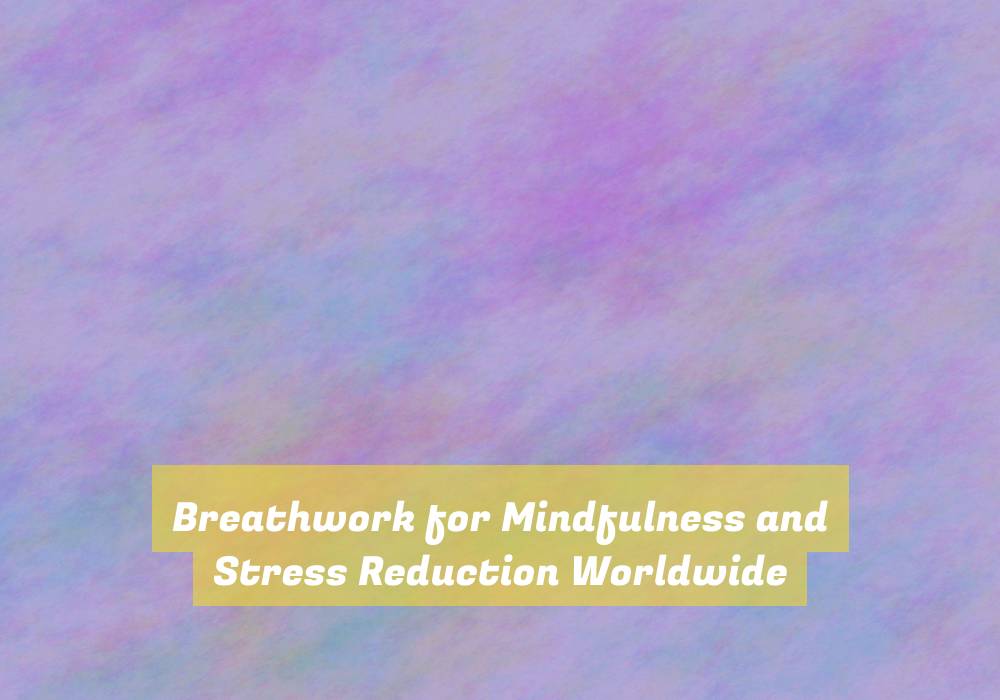Breathwork for Mindfulness and Stress Reduction Worldwide
Imagine a sailboat gliding across the ocean, its sails billowing in the wind. Just as the wind propels the boat forward, your breath can guide you towards a calmer, more mindful state.
As the world becomes increasingly fast-paced and stressful, the practice of breathwork has gained attention for its ability to alleviate anxiety and promote relaxation. From ancient yogic traditions to modern mindfulness techniques, breathwork has been embraced by cultures worldwide as a powerful tool for managing stress.
But how exactly does something as simple as breathing hold the key to unlocking a more peaceful state of mind?
The History of Breathwork
Breathwork has been practiced for centuries across various cultures and traditions, serving as a fundamental aspect of health and spirituality. The history of breathwork dates back to ancient civilizations such as India, China, and Greece, where specific breathing techniques were used for healing, meditation, and spiritual awakening.
In India, the practice of Pranayama, a form of breath control, was documented in ancient texts like the Upanishads and the Yoga Sutras. Similarly, in traditional Chinese medicine, the concept of Qi, or vital energy, is closely linked to breath and breathing exercises. Greek philosophers like Aristotle and Theophrastus also wrote about the importance of proper breathing for overall well-being.
Throughout history, breathwork has been integrated into various religious and spiritual practices. In the Christian tradition, breath is associated with the Holy Spirit, while in Sufism, the mystical branch of Islam, specific breathing techniques are used to attain spiritual enlightenment. Indigenous cultures across the world have also incorporated breathwork into their healing rituals and ceremonies.
Understanding the historical roots of breathwork provides valuable insight into its universal significance and enduring impact on human well-being.
Breathwork Techniques From Around the World
The historical roots of breathwork across different cultures have contributed to a rich tapestry of breathwork techniques from around the world, each offering unique insights into the practice and its applications.
In India, pranayama, a yogic breathing practice, focuses on controlling the breath to influence the flow of prana, or life force, within the body.
The Wim Hof Method, developed in the Netherlands, combines specific breathing patterns with cold exposure and mindset training to enhance physical and mental well-being.
Over in Japan, thereG??s the Hara breathing technique, which emphasizes deep, diaphragmatic breathing to center and ground oneself.
In Native American traditions, breathwork is often integrated into sacred ceremonies and rituals, such as the use of breath to connect with the spirit world.
The Hawaiian practice of piko-piko breathing involves rhythmic breathing through the nostrils to restore balance and harmony.
These diverse breathwork techniques showcase the universal significance of breath as a tool for mindfulness and stress reduction, offering a global perspective on the profound impact of intentional breathing practices.
Scientific Evidence Supporting Breathwork
Amidst the growing interest in holistic wellness practices, scientific research has increasingly supported the efficacy of breathwork for promoting mindfulness and reducing stress. Studies have shown that intentional breathing techniques can have a significant impact on the nervous system, leading to reduced stress levels and improved mental well-being.
For example, research has demonstrated that deep breathing exercises can activate the parasympathetic nervous system, which is responsible for promoting relaxation and reducing the bodyG??s stress response.
Furthermore, studies have found that breathwork can positively influence emotional regulation and cognitive function. By engaging in focused breathing practices, individuals can enhance their ability to manage emotions and maintain mental clarity, even in challenging situations. Additionally, research has indicated that breathwork can contribute to improved sleep quality and overall resilience to stress.
Moreover, scientific evidence has highlighted the potential of breathwork to complement traditional therapeutic approaches for conditions such as anxiety disorders, post-traumatic stress disorder (PTSD), and depression. As researchers continue to explore the physiological and psychological effects of breathwork, the evidence supporting its role in promoting mindfulness and stress reduction continues to grow.
Incorporating Breathwork Into Daily Life
As you explore ways to enhance your daily well-being, consider incorporating breathwork into your routine for mindfulness and stress reduction.
Begin by setting aside a few minutes each day to focus on your breath. This can be done in the morning to start your day with a sense of calm, or in the evening to unwind and release any tension from the day.
Try incorporating breathwork into activities you already do, such as yoga, meditation, or even while taking a walk. You can also use breathwork as a tool to manage stress during challenging moments throughout your day. By consciously focusing on your breath, you can bring yourself back to the present moment and reduce feelings of anxiety or overwhelm.
Additionally, consider finding a breathwork technique that resonates with you, whether itG??s deep belly breathing, box breathing, or alternate nostril breathing.
Conclusion
So, next time youG??re feeling stressed or overwhelmed, take a moment to practice some breathwork. ItG??s a simple yet effective way to bring mindfulness into your life and reduce stress.
With techniques from around the world and scientific evidence supporting its benefits, breathwork is a powerful tool for improving mental and emotional well-being.
Incorporate breathwork into your daily routine and experience the positive impact it can have on your overall health and happiness.







What a beautiful analogy using the sailboat! It makes me reflect on how our breath can indeed serve as both anchor and sail in the stormy seas of modern life. I’ve dabbled in breathwork practices like pranayama and found them transformative, especially in moments of high stress. It’s fascinating how these ancient techniques have evolved yet remain fundamentally effective across various cultures.
I appreciate your thoughts on the sailboat analogy. It’s interesting how our breath can act as both an anchor and a sail. In moments of turbulence, grounding ourselves with breath can help stabilize our thoughts and emotions, just like dropping an anchor in a storm. On the flip side, using breath as a sail can propel us forward, giving us clarity and strength when navigating life’s challenges.